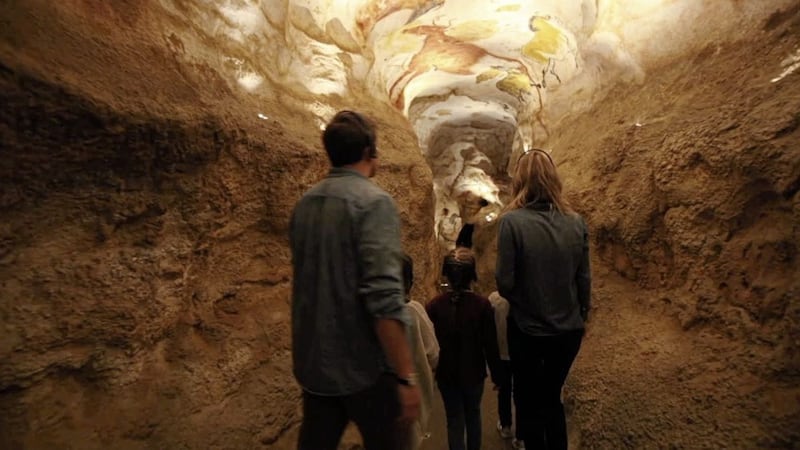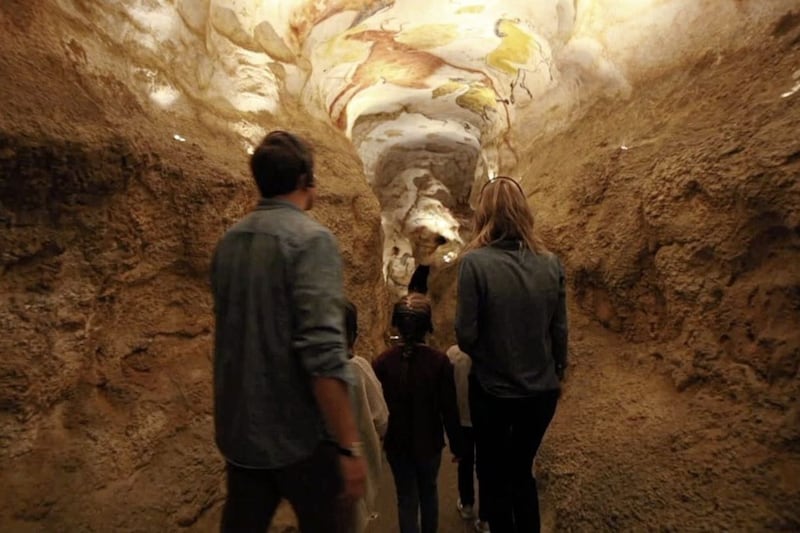ARTWORK from 18,000 years ago is captivating the French public imagination as never before. The prehistoric Lascaux cave paintings near Montignac were discovered in September 1940 by an inquisitive dog and four teenagers, and word quickly spread about their artistic secret.
The paintings of wild animals astonished archaeologists and three months later were declared an historic monument. Tourists flocked to see them but the images became damaged by pollution so the caves were closed to the public. Now, 76 years on from the discovery, a team of 30 artists has topographically recreated the original drawings in a new €57 million centre opened in December.
The 21st century pride of the Dordogne is known as Lascaux IV and is attracting thousands of visitors to the Vézère Valley, a serene part of the rural south west. Such is the depth of interest that throughout the day, every six minutes, a group of 35 sets off on a tour through a labyrinth of narrow tunnels and passageways.
Our tour starts on the flat roof of the long, low building which, like the Cliffs of Moher centre in Co Clare, blends into the landscape. It reflects the line of the tree-covered mountainside, an unprepossessing hill just 100 metres from the original cave that belies its worldwide artistic fame.
Leaving the bright sunlight, we adjust our eyes to the soft light in the Hall of the Bulls, immersing ourselves in the decorated cave’s first room. With her red laser pointer, the guide highlights black bulls, a large bison with an engraved eye, fighting ibexes on the walls and ceiling, and aurochs, a species extinct today. Using ultrafine paintbrushes, horsehair brushes and even toothbrushes, along with cutting-edge technology, the artists and engravers reconstructed the paintings over three years. Painstakingly, they reproduced every bump, rough patch and subtle nuance, adhering with millimetre accuracy to mirror the prehistoric originals, so the visitor can discover the cave as it was in 1940.
Many paintings are on sparkling white calcite while others are on limestone. The dominant pigments in the palette are ochre, mustard, red and black, creating a moody atmosphere. We are led through the Axial gallery that has been dubbed the ‘Sistine Chapel of Prehistory’ and is considered the pinnacle of cave art. The gallery features a variety of carefully depicted action shots of cows and ibexes, alongside a superb frieze of a flurry of small horses with precise form and colour.
The parade of animals in the Lascaux bestiary includes mountain goats, deer, oryx and rhinoceros, while everywhere cows and horses with multiple heads appear in overhangs and recesses. Some animals have short limbs, others have exaggerated bloated bellies. Our final stop is the nave, a high-ceilinged gallery that reflects a sense of spirituality. A stand-out image is five swimming stags creating the impression of fording a river with only their heads visible.
The profusion of paintings produces a mix of awe and wonder, and raises more questions than answers. No-one really knows the true meaning of these enigmatic paintings, which is part of the attraction for many visitors. Some experts suggest the animals may have played a role in the beliefs and spiritual life of early humans; or were they produced by prehistoric dreamers?
Whatever the answers, there is no doubting the huge interest in the Lascaux centre since its opening. In the first six months, more than 200,000 people have viewed the facsimiles which combine scientific rigour and artistic sensitivity allied to an inscrutability about their meaning.
You can, of course, put your own interpretation on it, and after the guided tour, the Gallery of the Imagination allows you to create art through giant touch screens. The new centre has popularised wall paintings and brought them to a new generation. The intimacy of the drawings and the confined underground space is thrilling; even though everyone understands that it is a reproduction, an overwhelming sense of history and mystery floods across the narrow passageways.
Delving into cave art is only one aspect of a holiday in the Dordogne since there are many choices for sightseeing. The area is best explored by car. Distances between the small bastide towns are no more than 20 minutes and even in high summer the roads are remarkably traffic-free. The area may lack the natural grandeur of beaches or mountains, but the medieval perched villages are set among spectacular looped drives in richly luxuriant valleys. Some, such as Domme and La Roque Gageac are dramatically sited on clifftops.
Artwork of a different kind, in the form of sculpted topiary, is on display at the gardens of Marqueyssac, a delightful place to spend an afternoon and listed as a national historic monument. The high-pitched screams of peacocks welcome you to look around 150,000 hand-pruned box trees and some stunning topiary.
The trees, which are hardy evergreens and easy to shape, have adapted to the chalky soil and are regarded as symbols of immortality. Walk around the maze of exquisite hedges and shaded paths, and from the Belvédère – the highest point – views stretch in all directions across verdant pastureland.
Another relaxing way to soak up the landscape is to board a traditional gabarre, a flat-bottomed wooden boat, for an excursion down the wide Dordogne river. The name Dordogne comes from the conjoining of two rivers: the Dore and the Dogne. The journey, with English commentary, takes an hour and leaves Beynac-et-Cazenac with its mighty feudal fortress presiding majestically over the town. The boat winds past farmland, forests, gold-stone villages and chateaux.
One of the least polluted rivers in Europe, the Dordogne has excellent stocks of pike, carp and trout, as well as salmon, sturgeon and lamprey. On our journey, we spot little egrets and a blue heron standing in the shallows. Scores of busy dragonflies follow our boat, swirling around like mini-helicopters, feeding voraciously on water buttercups. Popular activities for all the family include recreational canoeing, kayaking and stand-up paddleboarding.
Accommodation ranges from Logis hotels to elegant chateaux such as Mont-d’Onel at Couze et Saint Front, run by a former Welsh golf pro, where breakfast is served on a sun-filled terrace. Or you can opt for a stylish cottage on a working farm in idyllic countryside 20 minutes from Bergerac.
Domaine de la Valette is run by Fabienne Bourgeois, who speaks impeccable English, and her husband Arnaud. They will explain their rare breeds of cattle and horses and give advice on local attractions.
In his impressionistic travel book The Colossus of Maroussi (1941), Henry Miller described this peaceful region of France as a sacred spot. Summing up what many visitors feel, he added: "It was most important for me to have seen the Dordogne: it gives me hope for the future of the race, for the future of the Earth itself."
FACT BOX
:: Irish Ferries operates the Oscar Wilde from Rosslare to Roscoff from where it is a six-hour drive to the Dordogne. Cabins range from two-star to luxury and all are air-conditioned. Prices vary depending on the time of year, so it is best to check the website for special deals: www.irishferries.com
:: Lascaux International Centre for Cave Art, 24290 Montignac: www.lascaux.fr/en adults €16, family pass €44.90
:: Marqueyssac Gardens, 24220 Vezac: www.marqueyssac.com, €9
:: Gabarres de Beynac river cruise: 24220 Beynac: www.gabarre-beynac.com, €8.50
:: Chateau Mont-d’Onel, 24159 Couze et Saint Front: www.montdonel.com, €155 pp B&B
:: Domaine de la Valette cottages, min. 3 nights in summer, weekly lets from €1,200: www.lavaletteperigord.com/en
:: La belle étoile hotel and restaurant, 24250 La Roque Gageac: www.belleetoile.fr
The Dordogne Pass allows access to 40 different tourist sites and activities with discounts of up to 50 per cent
:: France tourism information: uk.france.fr/en/dordogne



